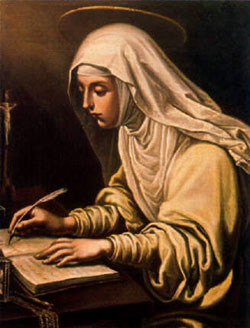
Feastday: February 13
Birth: 1522
Death: 1589
St. Catherine was born in Florence in 1522. Her baptismal name was Alexandrina, but she took the name of Catherine upon entering religion. From her earliest infancy she manifested a great love of prayer, and in her sixth year, her father placed her in the convent of Monticelli in Florence, where her aunt, Louisa de Ricci, was a nun. After a brief return home, she entered the convent of the Dominican nuns at Prat in Tuscany, in her fourteenth year. While very young, she was chosen Mistress of Novices, then subprioress, and at twenty-five years of age she became perpetual prioress. The reputation of her sanctity drew to her side many illustrious personages, among whom three later sat in the chair of Peter, namely Cerveni, Alexander de Medicis, and Aldo Brandini, and afterward Marcellus II, Clement VIII, and Leo XI respectively. She corresponded with St. Philip Neri and, while still living, she appeared to him in Rome in a miraculous manner.She is famous for the "Ecstacy of the Passion" which she experienced every Thursday from noon until Friday at 4:00 p.m. for twelve years. After a long illness she passed away in 1589. Her feast day is February 13.
Catherine de' Ricci (Italian: Caterina de' Ricci) (23 April 1522 – 2 February 1590), was an Italian Dominican Tertiary sister. She is believed to have had miraculous visions and corporeal encounters with Jesus, both with the infant Jesus and with the adult Jesus. She is said to have spontaneously bled with the wounds of the crucified Christ. She is venerated for her mystic visions and is honored as a saint by the Catholic Church.
Life
She was born Alessandra Lucrezia Romola de' Ricci in Florence to Pier Francesco de' Ricci, of a patrician family, and his wife, Caterina Bonza, who died soon after. At age 6 or 7, her father enrolled her in a school run by a monastery of Benedictine nuns in the Monticelli quarter of the city, near their home, where her aunt, Luisa de' Ricci, was the abbess. She was a very prayerful person from a very young age. There she developed a lifelong devotion to the Passion of Christ. After a short time outside the monastery she entered the Convent of St Vincent in Prato, Tuscany, a cloistered community of religious sisters of the Third Order of St. Dominic, disciples of the noted Dominican friar Girolamo Savonarola, who followed the strict regimen of life she desired. In May 1535 she received the religious habit from her uncle, Timoteo de' Ricci, who was confessor to the convent, and the religious name of Catherine, after the Dominican tertiary, Catherine of Siena.
De' Ricci's period of novitiate was a time of trial. She would experience ecstasies during her routine, which caused her to seem asleep during community prayer services, dropping plates and food, so much so that the community began to question her competence, if not her sanity. Eventually the other Sisters became aware of the spiritual basis for her behavior. By the age of 30 she had risen to the post of prioress.
She is reported to have been a nun with visions, states Constance Classen, who miraculously held baby Jesus dressed in swaddling clothes, and was mystically married and united with adult Jesus.
As the prioress, De' Ricci developed into an effective and greatly admired administrator. She was an advisor on various topics to princes, bishops and cardinals. She corresponded with three figures who were destined to become popes: Pope Marcellus II, Pope Clement VIII, and Pope Leo XI. An expert on religion, management and administration, her advice was widely sought. She gave counsel both in person and through exchanging letters. It is reported that she was extremely effective and efficient in her work, managing her priorities very well.
It is claimed that De' Ricci's meditation on the Passion of Christ was so deep that she spontaneously bled, as if scourged. She also bore the Stigmata. During times of deep prayer, like Catherine of Siena, her patron saint, a coral ring representing her marriage to Christ, appeared on her finger.
It is reported that De' Ricci wore an iron chain around her neck, engaged in extreme fasting and other forms of penance and sacrifice, especially for souls in Purgatory.
One of the miracles that was documented for her canonization was her appearance many hundreds of miles away from where she was physically located in a vision to Philip Neri, a resident of Rome, with whom she had maintained a long-term correspondence. Neri, who was otherwise very reluctant to discuss miraculous events, confirmed the event.
De' Ricci lived in the convent until her death in 1590 after a prolonged illness. Her remains are visible under the altar of the Minor Basilica of Santi Vicenzo e Caterina de' Ricci, Prato, which is next to the convent associated with her life.
Veneration
De' Ricci was beatified by Pope Clement XII in 1732, and canonized by Pope Benedict XIV in 1746. Her feast day falls on 2 February.
| Wikimedia Commons has media related to Caterina de' Ricci. |
-
Image at Basilica.






